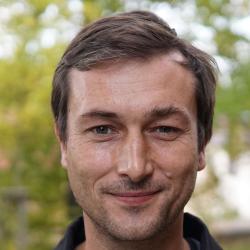In the last two posts I have reported on the scientific sessions of the Fucino15 conference and on the first of the field trips. This post is about the L’Aquila field trip. I haven’t been to this city before and I was curious to see the place that sadly became so famous in earthquake science. I was surprised by how many heavily damaged buildings were still standing and by the overwhelming amount of historical buildings that await their reconstruction. We were given a great tour through the Palazzo Ardinghelli which is currently being rebuilt, then we had a look at the worst-affected parts of the city. Here’s a report in images. more
-
This was the Fucino15 meeting – part III
2015-05-07 | in Earthquake, Italy 2015 -
This was the Fucino15 meeting – part II
2015-05-03 | in Italy 2015I blogged about the scientific sessions at the Fucino15 meeting last week, here’s my report about the pre- and post-meeting field trips. The pre-meeting field trip was held in Rome, where we explored the archaeological and historical evidence for earthquake damage in the Eternal City. After the conference we followed the traces of the 1915 Fucino earthquake and then finally visited L’Aquila. This blog covers Rome and the geological field trips, a special on L’Aquila will follow later. more
-
This was the Fucino15 meeting – part I
2015-04-29 | in Italy 2015, MeetingPhew, this was an intense week and a great one too! The Fucino15 meeting on paleoseismology, active tectonics and archaeoseismology is over and hopefully everyone safely arrived back home. Here’s a brief report on some of the science that happened at the meeting. Since we had ~50 oral presentations, only an overview is possible here. In the following days I’ll add more details about the field trips. A big thank you to the Italian organizing team who did an amazing job – grazie mille! more
-
Fucino2015 conference – Program out now!
2015-04-07 | in Italy 2015, MeetingThe most important paleoseismology event of the year is just a few days ahead and we’re all excited to meet in sunny Italy. The 6th INQUA International Workshop on Active Tectonics Paleoseismology and Archaeoseismology will be held from 19-24 April 2015 in Pescina, Fucino Basin, Italy. The meeting will commemorate the 100th anniversary of the devastating 1915 Fucino earthquake. Make sure to check the final program which is now available for download at the meeting website: download here (PDF, 9 mb).
-
Deadline for the Colloquium on Historical EQs in the Rhine Graben postponed to 3 April
2015-03-29 | in MeetingGood news for the late birds – the abstracts deadline for the Colloquium on “Historical Earthquakes of the Rhine Graben and Interplate – Intraplate Continental Deformation: From archives to comparative seismotectonics” has been postponed to 3 April.
The meeting will be held from 11-13 May 2015 in Strasbourg (Inst. de Physique du Globe). The second circular is out with more details on the programme, download the PDF here.
-
Submarine Paleoseismology Workshop at ETH Zurich, 16-18 July 2015
2015-03-23 | in MeetingFrom 16-18 July, 2015, an interesting workshop will be held at ETH Zurich (Switzerland): Submarine Paleoseismology – Using giant piston coring within IODP to fill the gap in long-term records of great earthquakes.
Michael Strasser, one of the main organizer, names the aims of the workshop: “The main topic of the workshop is to discuss and define a strategy how and where we could best make use of giant piston coring efforts within the Integrated Ocean Discovery Program (IODP) to make some major advancements in submarine paleoseismology to constrain earthquake recurrence beyond historical times.” more
-
Stuff to read – latest papers on paleoseismology, archaeoseismology, and tsunamis
-
Tectonics from above – RAS discussion meeting
2015-03-16 | in Earthquake, Field work, MeetingLast Friday the RAS held a discussion meeting on Tectonics from Above: Recent Advances in the Use of High-resolution Topography and Imagery in London. Almost the entire Cambridge Tectonics Group went there and I absolutely enjoyed the meeting and the discussion with friends and colleagues mainly from the UK and from France. The speakers reported on open-source software for producing high-res DEMs, advances in aerial and satellite imagery, new techniques in remote sensing, and latest developments in fault/offset mapping. The meeting was supported by NERC, COMET+ and LICS. more
-
Remembering the 1945 Makran Tsunami – Free book: interviews with survivors
This year marks the 70th anniversary of the Makran Earthquake and Tsunami. On 27 November, 1945, an earthquake of magnitude Mw8.1 occurred at the Makran Subduction Zone offshore Pakistan. A large tsunami was triggered that reached the coasts of Pakistan, Iran, India, and Oman. The quake and the waves left approx. 4,000 people dead. A new book collects interviews with survivors. The book has been published by the UNESCO through its Intergovernmental Oceanographic Commission and is available for free download here. more
-
A new Nuclear Power Plant near Karachi
2015-03-09 | in Earthquake, Opinion, TsunamiKarachi is the most populated city in Pakistan with around 24,000,000 inhabitants – just as many as Australia. Since many years a nuclear power plant (NPP) is located just a few miles outside the city at the shore. Ongoing work on new reactors with Chinese help has recently sparked outrage and media coverage. Concerns are that any accidents at the NPP might have dramatic consequences and threaten millions of people. I searched the recent scientific literature on seismic and tsunami hazard for Karachi…

